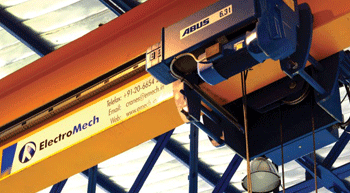
Changing Dynamics
The industrial cranes market in India is valued in the range of Rs 1,800-2,000 crore per annum. Approximately 30 per cent of the demand comes from government sector and PSUs while the remaining 70 per cent from private sector. In terms of region wise distribution, Western India contributes 50-55 per cent of the total requirement, while Southern India follows with 20-25 per cent, Northern India 15-20 per cent, and Eastern India with 5-10 per cent. The total volume for industrial cranes is estimated to be approximately 8,000-10,000 cranes per year. From the supply side, the market is highly fragmented, with over 300 crane manufacturers vying for a slice of the pie that is only five per cent the size of the demand for cranes in China. Such a market dynamic does not give any manufacturer the economies of scale that can allow focused investment on new product development. Hence, technological advancements in the industrial cranes market have been few and far between, leaving very little product differentiation.
The Indian customer is an ever-evolving customer. From being exposed to shoddy equipment a decade ago, today the Indian customer is the king with a choice of high quality equipment at his beck and call. Hence, naturally, the demands of the customers are also evolving. Initially, the customer used to have a single line focus of only the pricing aspect without bothering a lot about the technical comparisons between different offerings. However, now, the customer takes pains to go through the complete technical specifications and ensures that the end product encompasses all the functional aspects as well as other aspects like reliability, safety, ease of maintenance, etc.
Apart from the competition and the plethora of products available in the market, there has also been a shift in the mindsets of the consumers as well as manufacturers towards the overall aspect of customer service. Till a few years ago, after-sales service was available to customers only through the OEMs that they purchased the crane from. Large companies tended to have their own general maintenance teams who would also address breakdowns or regular maintenance of their cranes. However, this kind of after-sales service was typically limited to offering spares support and breakdown services. There was a lacuna in the market for a true expert in terms of crane care. It was to address this void that we established Cranedge. In addition to the regular services offered for cranes, Cranedge offers a host of services for industrial cranes of any make, anywhere in India.
These include:
- Lifecycle services for cranes, which include, crane health assessments, Annual maintenance contracts and other standalone services such as certifications, load testing, commissioning and relocations
- Services that help customers get more out of their existing equipment, which include modernizations, overhauling, repairs and capacity enhancements
- Spares and performance accessories: Cranedge is also in a position to develop specialised parts or spares and help customers with their spares inventory planning
- Consultation services such as operator trainings, crane performance audits and analysis and crane Kaizen.
In addition, we are seeing more and more customers willing to explore the possibility of sweating their existing assets for a longer period. This could be in terms of relocating cranes between facilities or reallocating them within a facility or even modifying cranes that have completed duty at a project site to suit the requirement at a new project. This offers substantial savings to clients both in terms of money as well as time, as was seen in the case of Soma?s Kochi Metro Rail Project, where we modified their existing cranes for use on this projects.
The author is Managing Director, ElectroMech Material Handling Systems (India).


 +91-22-24193000
+91-22-24193000 Subscriber@ASAPPinfoGlobal.com
Subscriber@ASAPPinfoGlobal.com